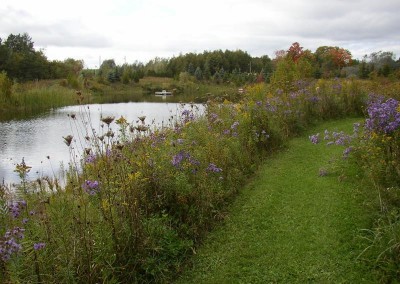Camalot Farm – 2009 Landscape Ontario: Award of Excellence
Camalot Farm – 2009
Landscape Ontario: Award of Excellence
This jewel of a pond, located in the ‘Headwaters’ area of Dufferin County has turned into both a natural wildlife refuge and a family recreational area.
Click Here To Read More About the Camalot Farm Project
With an intermittent stream running through the proposed pond site, the proposal to create an on-stream pond met with some resistance from the Nottawasaga Valley Conservation Authority and the Ministry of Natural Resources. The permit process was lengthy and only successful due to our starting the approval process well in advance of the construction of the pond. Site visits by biologists, an earlier letter from the Conservation Authority giving approval in principle for the pond, and detailed remediation efforts eventually led to the desired permit.
Heavy construction began in January and was competed by March. Test holes showed that the site was blessed with a base of lovely clay that would line the pond, and great topsoil that would encourage the quick regeneration and growth of plant material around the pond. Frozen ground led to better access to the existing cattail and bulrush marsh and was less disturbing to the wildlife using this area. The existing feeder stream was diverted for the duration of the construction with a temporary watercourse, and straw bales and filter cloth fencing were used to prevent sediment flow downstream. The five to six springs encountered within the boundaries of the pond required constant dewatering during construction, but ensured that the pond filled very quickly when construction was complete. A simple gravity based outflow keeps the pond level very consistent. Unless drought conditions occur, there is less than a 200mm variance on the water level throughout the summer months.
A varied and meandering edge to the pond was constructed to mimic a natural edge condition. The slopes of the pond edge also varied with some steep sides to discourage the emergent plants; but shallow sloping edges were also created to ensure easy access/egress from the pond for both people and wildlife. Two beach areas were constructed, with the main one closest to the house, and on the north side of the pond. This ensures that the prevailing wind blows any algae or debris to the lesser used south end of the pond. Fifty tons of sand were installed for the beach. Filter cloth was placed and covered with sand, to eventually be covered in water to form a clear beach entry area. Approximately forty tons of large granite boulders were placed in various locations around, in and at the edge of the pond. They serve as perches for wildlife and fishing, diving rocks for people, and serve to create an informal edge to the sand beach areas.
The pond depth varies from an average of ten to thirteen feet. There are two deep ‘holes’ with an eighteen to twenty foot depth, a spot for the fish to hang out in. The pond is stocked with both rainbow trout and largemouth bass. The trout come to the surface to catch bugs, and the bass eat small fish, tadpoles and any leeches that may come in from the pond from the north.
Berms were necessary on the western boundary of the pond, to retain the water, and provide a sound barrier and privacy from the busy road. The berm is divided by the existing inflow stream and undisturbed cattail and bulrush wetland that was a requirement of the conservation authority. The wetland area to the south of the pond and the outflow also remains in an undisturbed condition and provides an important nesting/wildlife refuge area. These areas were especially important for wildlife in the first year after construction, prior to the re-establishment of the groundcover areas.
Existing topsoil was stockpiled and re-utilized as quickly as possible so as to take advantage of the existing seed base, and in fact the re-establishment of native species went very quickly. Additional native seed mix was hand broadcast where necessary. The area around the pond is now left undisturbed; with the exception of a mown walking trail around the perimeter of the pond.
Native plantings were used throughout the pond site; in mixed groupings to enhance the natural look. Burr and swamp oak, black locust, sugar and red maple, cedar, dogwood, willow, serviceberry, snowberry, viburnum, white spruce and larch are some of the native species used. However, the privacy planting on the berm consists of mature Colorado Spruce, as the extreme wind and salt spray from vehicles on the road necessitated having a hardier species of trees in order for them to survive and thrive in the difficult growing conditions in that area.
A floating dock/diving platform is anchored near the centre of the pond and often has hordes of kids playing on it. A recent fishing derby saw 60 serious and not so serious anglers spending the day by the water’s edge as they tried to catch the big one ( a 3lb bass was the ultimate winner and dinner!). In the winter it serves as an open air skating rink-no admission required. The homeowner’s also heat their home geothermally with the pipes gathering heat from the pond.
The pond is home to turtles, crayfish, frogs, fish, frogs and is visited by osprey, great blue herons, sand hill cranes, mallard and wood ducks, migratory ducks and geese, kingfisher, purple martins and swallows, red winged blackbirds, etc.
In just a few short years, this pond has seamlessly and successfully blended in with the natural landscape, added valuable open water habitat for wildlife and provided endless recreational opportunities for the homeowners and friends.
















